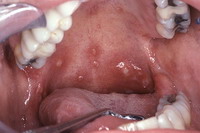New US estimates show higher level of HIV infection
New government estimates will show at least 35 percent more Americans are infected with the AIDS virus each year.

Government officials acknowledge they are revising the estimate, which they say is not yet complete.
But advocates are pushing for the government to release the number now. They say the delay may be partly political, and that it's hurting prevention funding.
"Across the AIDS community, there is an incredible amount of suspicion," said Julie Davids, executive director of the advocacy group Community HIV/AIDS Mobilization Project (CHAMP).
U.S. health officials have been estimating about 40,000 new HIV cases occur in the nation each year. However, at a national HIV prevention conference in Atlanta this week, advocates claimed the new estimate is 55,000 or higher.
The U.S. Centers for Disease Control and Prevention said the numbers are being reviewed for accuracy and will not be released until early next year.
The new estimate is based on new testing technology, said Dr. Kevin Fenton, who oversees CDC's prevention operations for AIDS and several other diseases.
The data have been submitted to a scientific journal for more rigorous review to ensure accuracy. They are expected to be released early next year, CDC officials said.
Estimates on new infections help health officials decide how much to spend on prevention programs.
While the estimated number of new infections has held steady at 40,000 for more than a decade, federal funding for HIV prevention in recent years has declined. Advocates say the trend has severely weakened community organizations that provide prevention and other services to people with HIV.
Although CDC has not released any number, the estimate of 55,000 has been circulating among various experts as part of the peer-review process, said Walt Senterfitt, a Los Angeles County epidemiologist who chairs CHAMP's governing board.
It's not clear if the rate of HIV infection has been rising, or whether previous estimates were simply wrong, Davids said.
"But either way, this shows that prevention efforts are insufficient," she said.
CHAMP officials say they believe the CDC is concerned about getting the new estimate right. But they added that advocates have been pushing for a better estimate for years, and that the Bush administration has suppressed important public health information before, including reports on global warming.
This would not be the first time AIDS statistics have been dramatically revised. Globally, the estimated number of people living with HIV fell from 40 million to 33 million last month after the United Nations AIDS agency cited new analysis.
Landing an accurate number has been difficult, for several reasons, CDC officials say. HIV can take several years to develop into visible illness, so new infections are not so easily spotted. Blood tests can reveal the virus, but most people do not get tested each year.
Also, HIV tests traditionally have not able to pinpoint when a person was infected. A new test can now show if infection occurred within the previous six months.
"It's difficult for us in the United States, and no surveillance system in the world is as sophisticated as ours," said Dr. Rob Janssen, director of the CDC's Division of HIV/AIDS Prevention.
Until 1992, the number of diagnosed AIDS cases was used to predict how many people were infected each year with HIV. That method produced an estimate of 40,000 to 80,000 new infections.
More recently, the CDC has focused on infections among men who have sex with men, who account for about half of new HIV diagnoses. They then extrapolated and adjusted the figure to come up with the 40,000 estimate for the entire U.S. population.
In 2005, the estimated number of people diagnosed with AIDS 40,608. The total number of people living with AIDS in the U.S. was put at 952,629.
Subscribe to Pravda.Ru Telegram channel, Facebook, RSS!


